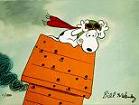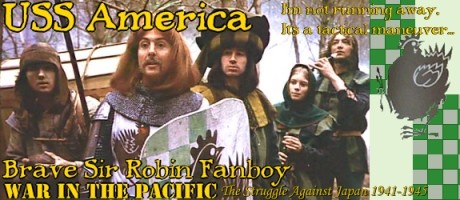Bullwinkle58
Posts: 11302
Joined: 2/24/2009
Status: offline

|
quote:
ORIGINAL: Nikademus
Good commentary. I'll want to read it again more carefully, however at this point i was only able to skim a bit. Mostly agree. The old Grigsby style of allowing you to control minute indiv. elements worked well back in the day because there were hardware limitations, but since then the hardware (aka the computer) has expanded exponentially in capability which allows the building block method to be expanded to the point where it becomes mind numbingly repetetive and overly commplex.
For me......my heart fell the most in WitE when i tried to just look at the basic divisional unit in the game. Back in Grigsby "Lite" days, you'd see the unit reasonably laid out......exp, morale, fatigue.......and for add'l detail #'s of squads, weapons, even specific AVF types for armored units. WitE? Holy crap........a HUGE spreadsheet denoting not only every device unit, but an exp value assigned to each subunit within the org of the div. So the Pz Grd component could have an exp level of 93 while Pz BN #1 would have an exp value of 95. WOW! not. The overall effect was overwhelming detail that ultimately means little. Why do i need to examine 16-20 different exp levels within a division's components when the average diff. is less than 5 points? Its cluttery, messy and ugly. Give me "War in Russia" any day over that.
Then there was the "flexible" ability to build an entire army (the Red Army at least) from the ground up.....from indiv BN's and companies all the way up to Corps. Back in the day you could build "divisions" using a couple of templates. Detailed yet easy to use. Now......practically need a college course on Army management and org theory. I feel like PM'ing JoeW, Chez and other military types along with a statician like JWE to teach me how best to proceed.
Its crazy. Note.....the scale remains the same.....the war in Russia. What changed? the level of detail using the same Grigsby type model. But its gone too far. And of course the more detail and player control over said detail you provide.....the more opportunities for exploitation of the rules. One of the biggest complaints i've seen on the WitE forums is that while the German army is constrained to a set model......the Red Army player can litterally customize his or her army to best exploit the rules. Sound familiar? in WitP or AE.....that takes place in the economy....The Japanese player can exploit rules and build reams of only the best devices that will give the best results from the die rolls.
Warning signs were there back even in the day. I'll never forget the otherwise awesome game that was USAAF.....but with the Luft. player able to 'control' the economy could soon produce fleets of only FW190's (vs. a mix of 109/190) because stat wise that type gave the best results.....and then after that...build all jets. But Player two was hamstrung by no production to be altered. If it could....the result would have been equally silly.....all P51's or 47's.......whatever gives the best die rolls.
Control and detail are good things....but they are also traps. Hence i think the developers of the future need to step back, esp. now given how powerful our hardware has become with Skynet like processors and Terabyte hard drives along with Gigs of onboard RAM.
That or they need to develop "team" wargames that allow people to take on limited and/or specific roles.....such as has been described to me in the days of board games.
A lot of good thoughts. I don't want to talk a lot about WitE here (boring for most AEers), but the design decisions made there and the movement away from some WITP techniques by GG are illustrative of where a next gen mega-game could go. WitE had some better ideas, but still didn't go all the way to what the PC equipment can do. It still requires way, way too much player mental overhead on the mundane at the expense of strategic thought.
I know exactly which mega-spreadsheet you're referring to. My reaction the first time I opened it was "My eyes! My eyes!" It is the best example of GG's penchant for substituting human brain work for code which pre-chunks and pre-analyzes/organizes information, which PCs excel at. The grogs--at first--probably like having every . . . single . . . thing . . . in one place in one mega display, but over a short time it becomes such a weary task to find what you need to DO SOMETHING.
Long, long ago, almost thirty years in fact (crap!), legendary game designer Sid Meier, one of the founders of Microprose and the idea man behind "Civilization", laid out his core idea for interesting game design (paraphrased): "A good game is simply a series of interesting decisions demanded of the player which collectively have a downstream effect." Since then he has expanded this idea into Ten Rules for designers:
"Here are our 10 commandments that we live by:
1.Choose a topic you have a passion for. Game Design is about creativity.
2.Do research after the game is done. Tap into the player’s brain.
3.Define your axioms, refine your axioms. Prototype, prototype, prototype; sit in all the chairs.
4.Double it or cut it in half. You are more wrong than you think.
5.Make sure the player is having fun, not the designer/computer.
6.Games should be easy to start playing, but hard to stop playing.
7.Simple systems work together to create complexity.
8.Make it ‘Epic’!
9.Most important part of the game is the first and last 15 minutes.
10.Know when to stop, more is not always better and just because we can, doesn’t mean we should"
http://forums.joeuser.com/371093
I think GG often bends or breaks #5. By requiring manual, player effort to execute mundane, "housekeeping" tasks he cuts coding time but also offers grogs an illusion of control and "getting their arms around the whole pile." But it IS an illusion, especially for beginners. AE is a tremendously hard game to get into in part because after launch and front-end set up it just sits there, a huge map and a tool bar. There's no task breakdown suggested. Look at the first fifteen minutes of any "Civilization" game and the first fifteen of a GC. Which is more inviting?
By using simple, ergonomic analysis executed through common business analysis techniques like UML a designer would NEVER portray, say, submarine detection like AE does. Instead of forcing a player to remember to open an Ops Report, read the whole thing (no internal sub-sections!), find subs which have increased detection, write (x,y)s on a piece of paper, GO BACK to the map, scroll around to find the (x,y) (can't type it in and jump there, must forevermore scroll), and only then begin to make a decision on what to do with the spotted sub, a great designer does just this--makes the sub icon blink when the d/l increases. That's all. Make it blink. Let the player define the d/l threshold in a set-up module if you like, but give simple, visual feedback of tactically important events. Let me deal with the decision of what to do with the sub, not expend 90% of the effort just finding the darn thing.
I've been thinking overnight of how AE could be redesigned to make it manageable. I once studied some UML, and I was married to a big-time consultant who traveled the world ramming in enterprise-level systems like SAP at multinationals. Those systems are all about front-end analysis of operations, and breaking down corporate tasks into bite-sized chunks which can be coded to. AE is remarkably like a business enterprise. You have procurement, production, warehousing, transport, current operations, future operations and strat. planning, accounting (PPs), R&D, and even HR (Commanders). Each of these functional modules should be their own planning environment in the game, possibly under a function key, and cross-linked where required. The game should prompt the player to at least think about entering each module every turn. I believe in check-lists, in RL and in turn-based games.
GG always makes the map a core part of the interface, a mistake IMO. In WitE he tries to get half-pregnant by using tabs, and function keys under tabs, and map colors and shading, and it's partly successful, but the map is still king. WITP/AE is even more map-centric, and the source of a lot of the clicking. Why do I need to leave the 'I' key planning environment and go to the actual city and drill down when I want to expand a factory? Just give the order in the the 'I' table. But no, everything has to done locally at the hex after drilling multiple levels into the hex. Break down the hundreds of player tasks in the game, group them by function and cycle timing, put them together in modules, add templates and player-defined trigger points, and the game becomes manageable. Add things like in-game help and manual access, player-usable memo pads for planning notes attached to To-Do lists for each coming operation, split monitor screens when you do need map access to plan while in a sub-module, give the map zoomable graphics with the mouse wheel, and allow player-defined visual and feed-back environments so PBEM opponents don't need to experience the game in the same way, and the game becomes a lot more "comfortable" to live in for a year or two. It's still AE, but it's like the TNG Enterprise instead of Kirk's TOS model. Hand-sewn leather seats and plush carpets on the bridge instead of sharp corners and Styrene chairs.
Anyway, this has been my semi-annual woolgathering on What I'd Like WITP II to Look Like. I now return you to your regular programming . . .
< Message edited by Bullwinkle58 -- 4/12/2012 2:37:13 PM >
_____________________________
The Moose
|
 Printable Version
Printable Version






























 New Messages
New Messages No New Messages
No New Messages Hot Topic w/ New Messages
Hot Topic w/ New Messages Hot Topic w/o New Messages
Hot Topic w/o New Messages Locked w/ New Messages
Locked w/ New Messages Locked w/o New Messages
Locked w/o New Messages Post New Thread
Post New Thread